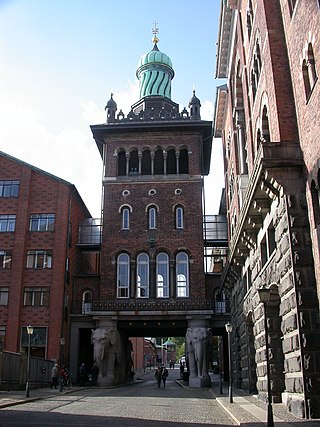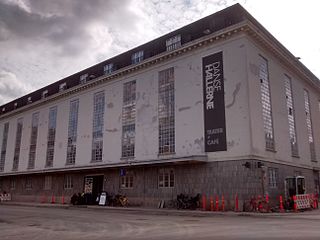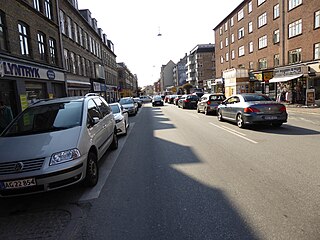
Carlsberg Lighthouse (Danish: Carlsberg Fyrtårn), also known as the Lime Tower (Danish: Kridttårnet) after the limestone which is its dominating building material, is a former lighthouse located in the Carlsberg area of Copenhagen, Denmark.

Carlsberg Lighthouse (Danish: Carlsberg Fyrtårn), also known as the Lime Tower (Danish: Kridttårnet) after the limestone which is its dominating building material, is a former lighthouse located in the Carlsberg area of Copenhagen, Denmark.


Built in 1883, the Lime Tower was originally part of a new main entrance for J.C. Jacobsen's Carlsberg Brewery site in Valby. The brewery had assumed the name Gammel Carlsberg (en: Old Carlsberg) after his son, Carl Jacobsen, due to a controversy between them, had established a new brewery which, with his father's consent, traded under the name Ny Carlsberg (en: New Carlsberg). The new main entrance was an arch, which incorporated the new name in gilded letters. The gate was connected to the Lime Tower by a wall which was also built in limestone. [1]
Electric lighting had been introduced in the brewery in 1882, at a time when it was still not widely available in Copenhagen. Since the site was also located on high ground, atop Valby Hill, it was decided to combine the guardhouse with a lighthouse.

The lighthouse is built to a Historicist design, drawing on Medieval castle towers for inspiration. It is built in limestone from Stevns and stands on a granite plinth.
The gate consists of two granite pillars which are connected by a cast iron arch featuring Gammel Carlsberg's name in gilded letters. The arch is topped by a 12-pointed star, a symbol which J. C. Jacobsen used as a trademark and had recently registered as such in the newly established trademark register. A series of dates, representing key events in the history of the brewery are inscribed on the pillars: 1847 for the first brew, 1867 for the year the brewery burned, 1870 for the building of the so-called Annex Brewery, and 1883 for the building of the Gate.
The light and guardhouse was rented out in 2009 and was used as a combined residence and studio by an artist. On 10th December 2021 the Swiss art gallery von Bartha opened a new gallery space located in the Carlsberg Lighthouse, continuing the gallery’s tradition of using distinctive architectural space.

Jacob Christian Jacobsen, mostly known as J. C. Jacobsen, was a Danish industrialist and philanthropist best known for founding the brewery Carlsberg.

Carlsberg A/S is a Danish multinational brewer. Founded in 1847 by J. C. Jacobsen, the company's headquarters is in Copenhagen, Denmark. Since Jacobsen's death in 1887, the majority owner of the company has been the Carlsberg Foundation. The company's flagship brand is Carlsberg. The company employs around 41,000 people, primarily in Europe and Asia. Carlsberg is currently the 6th largest brewery in the world based on revenue.

Carl Christian Hillman Jacobsen was a Danish brewer, art collector and philanthropist. Though often preoccupied with his cultural interests, Jacobsen was a shrewd and visionary businessman and initiated the transition of the brewery Carlsberg from a local Copenhagen brewery to the multinational conglomerate that it is today.

Valby ( ) is one of the 10 official districts of Copenhagen Municipality, Denmark. It is in the southwestern corner of Copenhagen Municipality, and has a mixture of different types of housing. This includes apartment blocks, terraced housing, areas with single-family houses and allotments, plus the remaining part of the old Valby village, around which the district has formed, intermingled with past and present industrial sites.

Carlsberg, is an area located straddling the border of Valby and Vesterbro districts in central Copenhagen, Denmark approximately 2.4 km from the City Hall Square. The area emerged when J.C. Jacobsen founded his original brewery in the district in 1847. The first brewing took place on 11 November 1847 and production continued until 30 October 2008, when production was moved to Fredericia in Jutland. The Jacobsen House Brewery is however still located in the district and produces specialty beers. The entire brewery grounds spread over more than 30 hectares and is currently being transformed into a new city district in Copenhagen.

Jens Vilhelm Dahlerup was a Danish architect who specialized in the Historicist style. One of the most productive and noted Danish architects of the 19th century, he is behind many of the most known buildings and landmarks of his time and has more than any other single architect contributed to the way Copenhagen appears today.

The Jesus Church is a church situated just off Valby Langgade in the Valby district of Copenhagen, Denmark. It was commissioned by second-generation Carlsberg brewer Carl Jacobsen and designed by Vilhelm Dahlerup. Noted for its extensive ornamentation and artwork, it is considered to be one of the country's most idiosyncratic and unconventional examples of church architecture. The church was built as a mausoleum for Carl Jacobsen and his family and is located close to their former house as well as the former Carlsberg brewery site. Their sarcophagi lie in the crypt. Throughout the church, there are ornaments and inscriptions associated with the family.

The Ny Carlsberg Brewhouse is a historic, listed building in the Carlsberg district of Copenhagen, Denmark, on the border between Vesterbro and Valby.

The Dipylon, or the Double Gate, is a landmark structure which spans Ny Carlsberg Vej in the Carlsberg area of Copenhagen, Denmark. Part of the now decommissioned Carlsberg Brewery site, it combines a double-arched gateway, from which it takes its name, with a clock tower.

The Elephant Tower is the most famous landmark of the Carlsberg district in Copenhagen, Denmark, the original brewery site of the Carlsberg Breweries. The tower takes its name from four large granite elephants which flank the gate, standing back to back carrying the tower on their backs.

Tap E is a former storage building of a bottling plant in the Vesterbro district of Copenhagen, Denmark, part of Carlsberg's historic brewery site which is now known simply as the Carlsberg area. After the production of beer in the area stopped in 2009, the listed building has been taken unto use as a cultural venue which houses both a centre for modern dance, Dansehallerne, and Fotografisk Center, a gallery and digital laboratory dedicated to fine art photography.

The Carl Jacobsen House is the former home of Carl Jacobsen and one of the listed buildings in the Carlsberg area of Copenhagen, Denmark.

Carlsberg Museum, situated next to the former home of Carl Jacobsen in the Carlsberg area of Copenhagen, Denmark, was the first home of his sculpture collection, now on display in the Ny Carlsberg Glyptotek in the city centre. The building consists of a total of 20 galleries accumulated between 1892 and 1895 through a series of extensions to designs by Vilhelm Dahlerup and Hack Kampmann. It now serves as a venue for conferences, receptions and other events.

Peter Christian Bønecke was a Danish architect.

Brolæggerstræde is a street in the Old Town of Copenhagen, Denmark, linking Nytorv in the west with Badstuestræde in the east. Most of the buildings in the street date from the years after the Copenhagen Fire of 1795. The Carlsberg Foundation is headquartered at No. 5.

Valby Langgade is one of the main streets of the Valby district of Copenhagen, Denmark. The c. 3.2 km long street runs from the southern end of Pile Allé and the Carlsberg neighbourhood in the east to Roskildevej at Damhus Lake in the west. The square and side street Valby Tingsted was the centre of the original village of Valby.

Carl Jacobsens Vej is a street in the Valby district of Copenhagen, Denmark. It runs from Sjælør Boulevard on the rear side of Vestre Cemetery in the east to Gammel Køge Landevej in the west. The street is lined by a mixture of converted industrial complexes from the beginning of the 20th century, building society developments and modern apartment buildings from the 2010s.

Knabrostræde is a street in the Old Town of Copenhagen, Denmark. It runs from Strøget (Vimmelskaftet/Nygade) in the northwest to Nybrogade at Slotsholmen Canal in the southeast, crossing Strædet (Kompagnistræde) on the way.

Hotel Ottilia is a 155-room boutique hotel operated by Brøchner Hotels in two former brewery buildings in the Carlsberg area of Copenhagen, Denmark. The older building, known as the Malt Chamber, is from 1881 and was designed by Vilhelm Dahlerup. The other one, Storage Cellar 3, was built to a Functionalist design in 1969. Both buildings are listed in the Danish registry of protected buildings and places. The hotel opened in 2019. It takes its name after Ottilia Jacobsen, the wife of second generation Carlsberg brewer Carl Jacobsen.

Ny Carlsberg Vej is a street in the Vesterbro district of Copenhagen, Denmark. It runs from Sønder Boulevard in the east to the point where Pile Allé turns into Valby Langgade at the southeastern corner of the park Søndermarken in the west. The last cobbled part of the street passes through the Carlsberg neighbourhood. This section of the street is spanned by the Dipylon Building and the Elephant Tower, both of which were designed by Vilhelm Dahlerup in the ornate Historicist style and are among the most iconic buildings of the former Carlsberg brewery site.